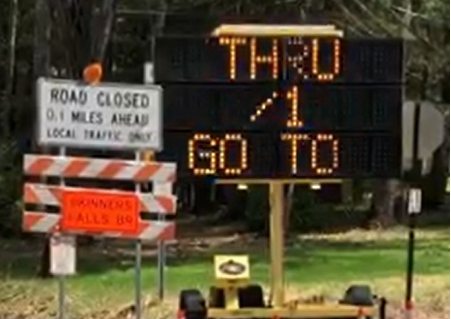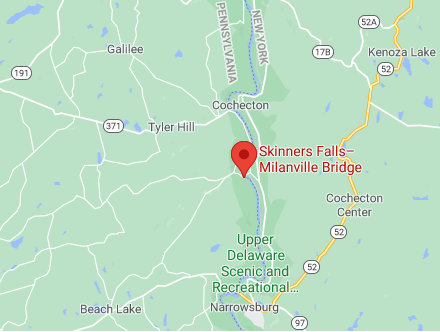
Skinners Falls Bridge Comment Period Extended
May 6, 2021
Greenworks Comprehensive Comments on the Skinners Falls Bridge
June 4, 2021This analysis of traffic sources and needs near the Skinners Falls Bridge shows that a 10-ton limit is adequate to meet all needs.
Until June 1, 2021, PennDOT is conducting what it is terming a “traffic survey” of the general public with regard to their habits and needs relative to use of the Milanville (aka Skinners Falls) Bridge. This will presumably furnish them with information that will help them determine whether we need a bridge there at all, and if so, of what kind.
It will be interesting to hear what the results of the survey are. However, a good look at a map of the area; combined with a knowledge of the small network of area roads near the bridge, the sources of the traffic that runs on them and the nearby population centers to which they connect, leads to a commonsense conclusion that anything more than a 10-ton limit on the Skinners Falls Bridge would be superfluous.
Let’s designate the area in question, the target area, as that falling between the two adjacent bridges, both of which can support traffic over 10 tons: upstream the Damascus-Cochecton Bridge, and downstream the Narrowsburg bridge.
With regard to this area, the material questions in deciding what weight limit is needed are:
- What percentage of the traffic in the target area will be seeking to cross the river and find itself closer to the Milanville Bridge than to either of the two others?
- Of this fraction, what percentage is likely to weigh more than 10 tons?
- For this still smaller fraction, how much further would it have to travel to get to an alternate bridge rather than the Milanville Bridge?
The below detailed analysis (download pdf) shows the answers to these questions to be:
- Small in NY; larger in PA
- Tiny approaching 0 on both sides
- Nominal on the New York side. Significant on the PA side by the time the vehicle in question gets close to Milanville. However, vehicles greater than 10 tons are overwhelmingly unlikely to originate in this area, with the closest likely sources of such traffic being State Route 652 or one of the major routes intersecting in Honesdale; from those originating areas, it’s actually shorter in both distance and time to go to the Narrowsburg Bridge.
Download the analysis as a pdf to see the details.
CONCLUSIONS FOR NEW YORK SIDE:
- Only one county route and two smaller back-country roads arrive at Route 97 closer to the Milanville Bridge than the closest alternatives up and down stream.
- The vast majority of traffic on these roads is likely to originate locally, and as such to consist of passenger and small commercial vehicles well under 10 tons.
- Ten-ton-plus traffic originating elsewhere and arriving in the target area is likely to be funneled either from Route 97 north and south, or from Route 52 via the small local/county roads. Such heavyweight traffic that arrives from north or south will hit the Narrowsburg or Damascus-Cochecton bridges before Skinners Falls. If any such traffic should arrive in the target area via the local/county roads, it still would not have to travel a prohibitive distance to find an alternative bridge.
CONCLUSION FOR PA SIDE:
- Only three roads, all of winding back-country character, feed into the PA side of the Milanville Bridge. Much of the traffic on these roads in the vicinity of the river will be closer to the Milanville Bridge than to the alternatives, emphasizing the need for a bridge of some kind there, especially on the PA side. However, as far as the needed weight limit:
- The vast majority of traffic on all these roads is likely to be local, which is to say rural, residential and small commercial; and indeed, one of these roads has a 10-ton limit and less than two full lanes in some places.
- The two other roads connect to more likely potential sources of 10-ton-plus traffic. However, for those sources, either the Narrowsburg or Damascus-Cochecton bridge provides a faster and more reasonable alternative, regardless of what the weight limit is on the Milanville Bridge.
BOTTOM LINE FOR THE RIVER:
Given the nature of the roads and population centers near the Skinners Falls Bridge, a weight limit over 10 tons would be superfluous, as traffic of that weight would keep right on heading over the Damascus-Cochecton and Narrowsburg bridges, both of which provide more reasonable and time-efficient approaches and connections for heavyweight vehicles.





1 Comment
I am supporting my friends in the rural area near the Milanville (or Skinners Falls) Bridge by advocating for the original structure to be retained, and repairs made to it, rather than widening it or enlarging it, which is not needed, as there are such crossings nearby in Damascus & Narrowsburg.